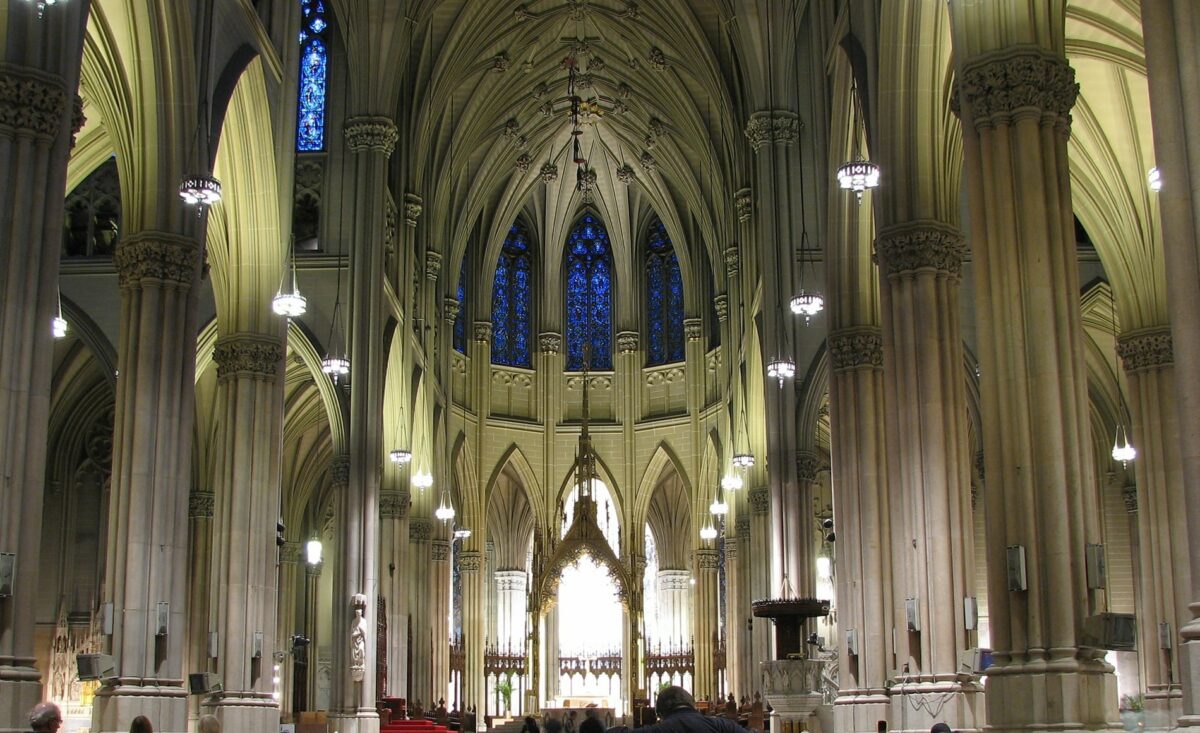The distinctive silhouette of St Patrick’s Cathedral emerges like an apparition between the skyscrapers of 5th Avenue in Manhattan. Its neo-Gothic architecture, with its slender spires and white marble façade, creates a striking contrast with the glass and steel towers that surround it. This architectural dialogue is part of the unique charm of New York, a city where ancient and modern coexist in perfect harmony.
The cathedral offers visitors a haven of peace in the midst of urban tumult. Stepping through its doors is like leaving the hustle and bustle of the city behind and entering a space of calm and contemplation. This abrupt transition is one of the most memorable experiences of a stay in Manhattan.
A Gothic testimony in the heart of modernity
The contrast effect: a unique spectacle
The sight of this neo-Gothic cathedral nestling between the modern giants of Rockefeller Center and the surrounding buildings creates a fascinating urban tableau. Amateur photographers will find exceptional angles here, particularly in the late afternoon when the sun reflects off the surrounding facades while illuminating the white marble of the building.
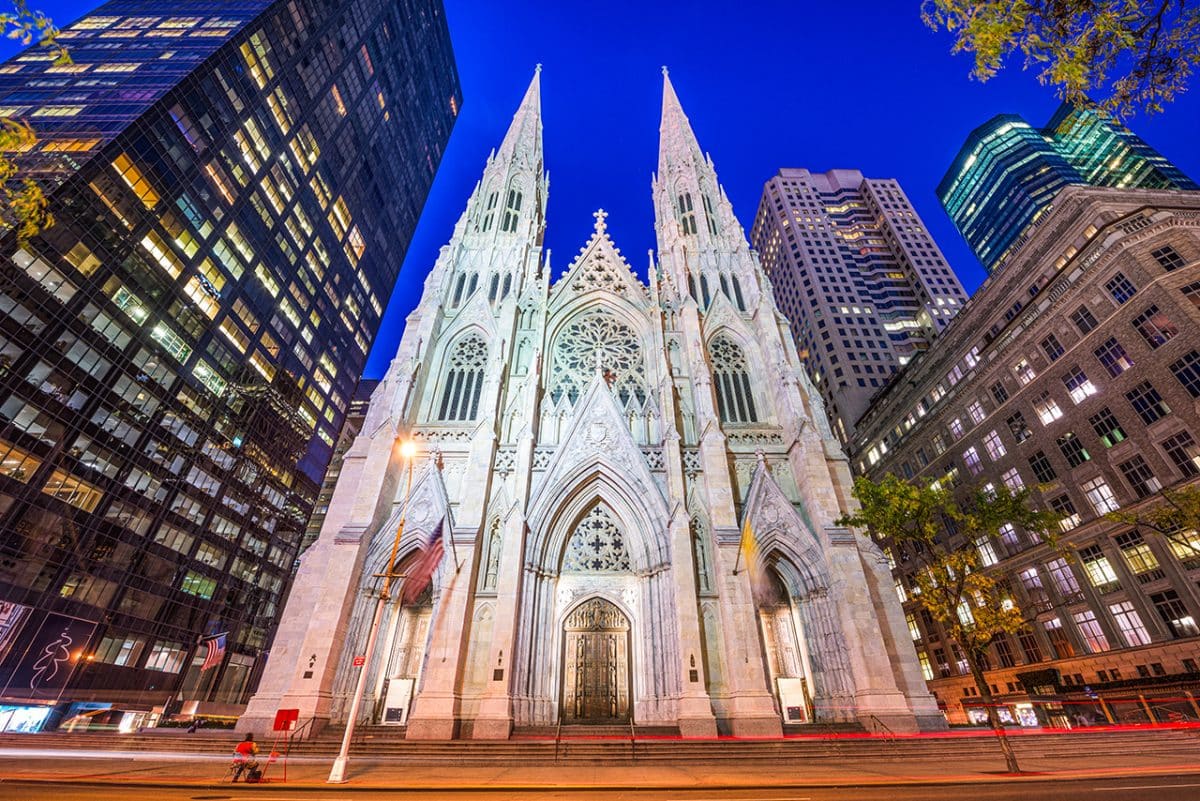
The historical roots of the building
Construction of St Patrick’s Cathedral in New York began on 15 August 1858, a few years before the outbreak of the American Civil War, which slowed down the work. It was nevertheless completed 20 years later, and it was on 25 May 1879 that the building was consecrated as a cathedral.
Architect James Renwick Jr supervised the final phases of construction, but in the years that followed, the cathedral underwent numerous improvements and extensions, including the creation of the towers on the west façade (1888).
The Chapel of the Virgin, with its stained glass windows designed by Paul Vincent Woodroffe, dates from 1912. The cathedral choir was also enlarged to accommodate the 7,000 pipes of the new organ built by George Kilgen & Son. Finally, it was during the 1940 restoration work that the magnificent bronze baldachin made its appearance, following a gift from Archbishop Francis Spellman.
The cathedral was built on the grounds of Dom Augustin Lestrange, a French abbot who already owned an orphanage on the site of one of New York’s most prestigious thoroughfares, Fifth Avenue, a stone’s throw from Rockefeller Center and the New York Palace Hotel, and not far from Carnegie Hall and Lincoln Center for the Performing Arts.
Irish heritage: at the heart of the identity
The decision to dedicate this cathedral to Saint Patrick, the patron saint ofIreland, was no accident. It was a tribute to the thousands of Irish immigrants who had found refuge in New York and who formed a significant part of the city’s Catholic community at the time. This historical dimension adds another layer of understanding to a visit to the site, which is much more than just a religious monument.
Technical and architectural feats
The cathedral’s imposing dimensions are impressive: 123 metres long, 84 metres wide and with interior vaults rising to a height of 34 metres. The two spires reach a height of 100 metres, creating a distinctive visual landmark in the urban landscape of Midtown Manhattan.
The white marble that makes up the bulk of the building comes from the Tuckahoe quarries, located in Westchester County in northern New York. The choice of a local material was not only pragmatic, but also gave the building a special luminosity that sets it apart from other neo-Gothic cathedrals.
Hidden treasures inside
The interior is home to 3,700 magnificent stained glass windows, some of which were designed in Chartres, France, Birmingham and Boston. The main rose window, located above the entrance, measures 8 metres in diameter and casts spectacular coloured light across the nave at different times of the day.
Among the cathedral’s remarkable works is a replica of Michelangelo‘s Pietà, three times the size of the original in St Peter’s Basilica in Rome. This monumental sculpture, created by William Ordway Partridge, is an emotional focal point of the visit.
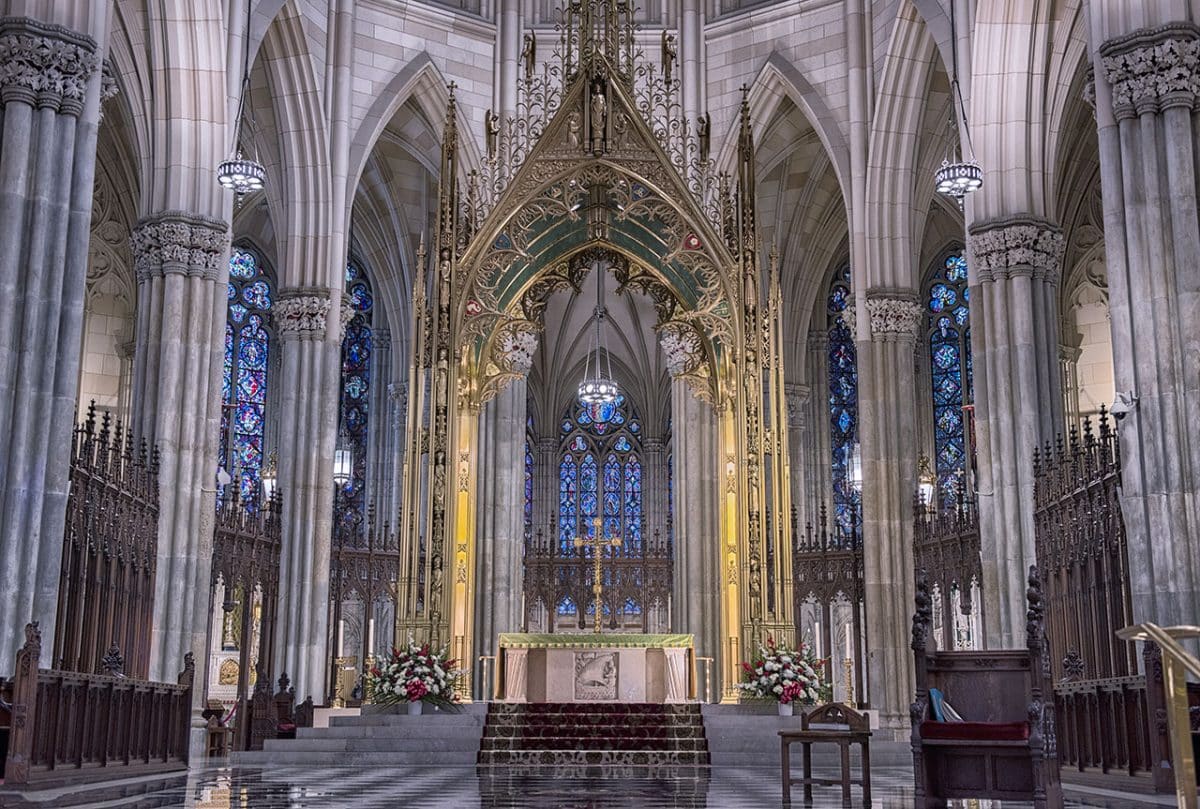
The visitor experience
The first contact with the cathedral from 5th Avenue is always a highlight. To fully appreciate it, take the time to observe it from the opposite pavement, which allows you to see the entire façade and spires. The contrast with Rockefeller Center just opposite is particularly photogenic.
Inside, the changing light coming through the stained glass windows creates a unique atmosphere depending on the time of day. Mornings generally offer a soft, diffused luminosity, while sunny afternoons transform the nave into a kaleidoscope of bright colours projected onto the white marble columns.
The sounds of the cathedral
The cathedral’s exceptional acoustics deserve special attention. If you are lucky enough to attend an organ concert or a mass with choir (particularly the one on Sundays at 10.15am), you will be able to fully appreciate the building’s sound qualities. The great organs, installed in the first half of the 20th century, are a major instrument that enhances the acoustics.
A cultural role beyond religion
St Patrick’s Cathedral regularly features in American films and television series. This media presence contributes to its status as a New York cultural icon, well beyond its religious dimension. It is one of those places that define Manhattan ‘s visual identity in the collective imagination.
As a witness to historic events, the cathedral has hosted the funerals of such luminaries as baseball legend Babe Ruth, Latin music icon Celia Cruz and Robert F. Kennedy. These moments have anchored the building in the contemporary history of the United States.
A meeting place in times of crisis
After the attacks of 11 September 2001, the cathedral became an essential place of meditation for many New Yorkers of all faiths. More recently, during the COVID-19 pandemic, it adapted by broadcasting its masses online, thus maintaining its role of spiritual support in exceptional circumstances.
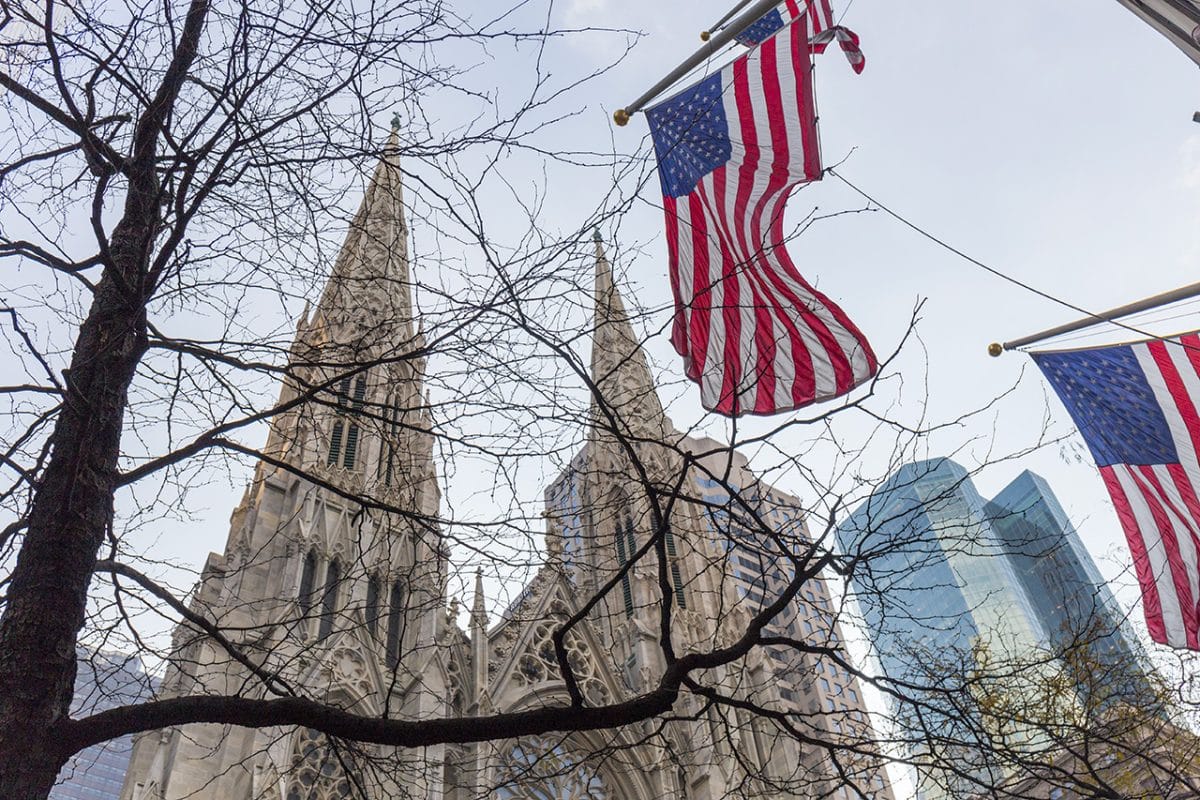
The living cathedral
With its 5.5 million annual visitors, St Patrick’s Cathedral is one of the busiest sites in New York. Yet it maintains its primary function as an active place of worship, with daily masses and special celebrations that punctuate the liturgical year.
Major celebrations such as Christmas Mass and St Patrick’s Day Mass (17 March) attract huge crowds and offer a unique experience of the building. These festive occasions allow visitors to appreciate the cathedral in all its splendour, with its special decoration and atmosphere.
Between tourism and contemplation
Managing the flow of visitors is a constant challenge for the cathedral, which must reconcile its tourist vocation with its spiritual mission. For a more leisurely visit, opt for early mornings (before 9am) or late afternoons (after 4pm) on weekdays, avoiding mass times.
Preserving our heritage
The major restoration work undertaken between 2012 and 2015, at a cost of 177 million dollars, has restored the building to its former glory. The work involved cleaning the marble façades, repairing the stained glass windows, restoring the interior woodwork and updating the technical systems.
Environmental innovation is an integral part of this conservation approach, with the installation of a geothermal system to heat and cool the cathedral. This initiative reflects a desire to reconcile heritage preservation with ecological awareness.
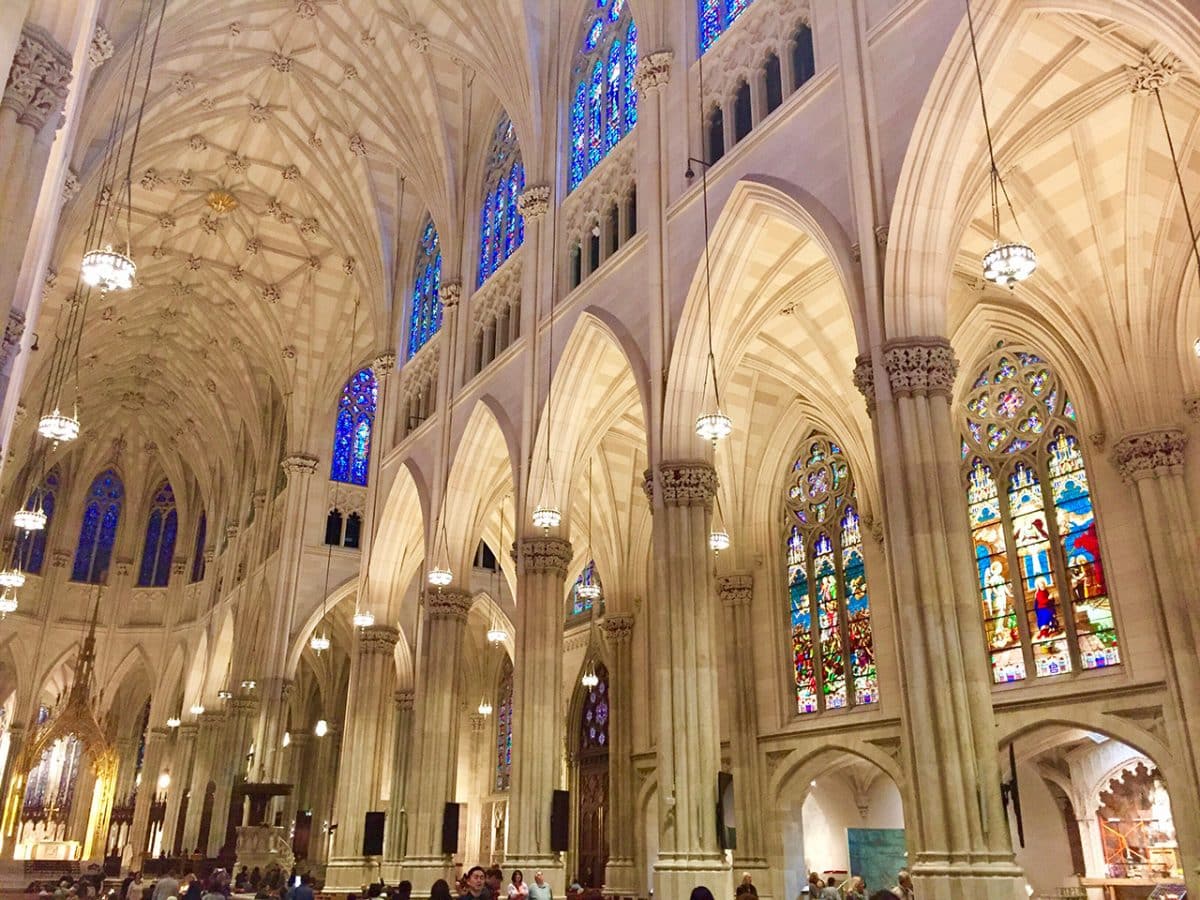
Practical visitor guide
The cathedral is open every day from 6.30am to 8.45pm, and admission is free. For an enhanced visit, an audio guide is available for €24, in several languages including French, English, Spanish, Italian and Portuguese.
There is a wide range of mass times: weekdays at 7am, 7.30am, 8am, 12pm, 12.30pm, 1pm and 5.30pm; Sundays at 7am, 8am, 9am, 10.15am (with choir), 12pm, 1pm, 4pm (in Spanish) and 5.30pm; Saturdays at 8am, 12pm and 5.30pm.
Photography tips
To capture the magic of the stained glass windows, it’s best to visit on a sunny day, ideally between 11am and 3pm when the light shines directly through the windows. A tripod is not allowed inside, but modern cameras allow you to take excellent low-light shots without accessories.
Key information
The cathedral is ideally located at the corner of 5th Avenue and 50th Street. It is easily accessible by metro on several lines: B, D, F, M ( 47th-50th Streets-Rockefeller Center station) or E, M ( 5th Avenue/53rd Street station).
Rockefeller Center (200m) and MoMA (Museum of Modern Art, 300m) are within 300 metres, making it easy to organise a day’s sightseeing in this part of Midtown. The cathedral is also less than 10 minutes’ walk from Times Square and within easy reach of Central Park.
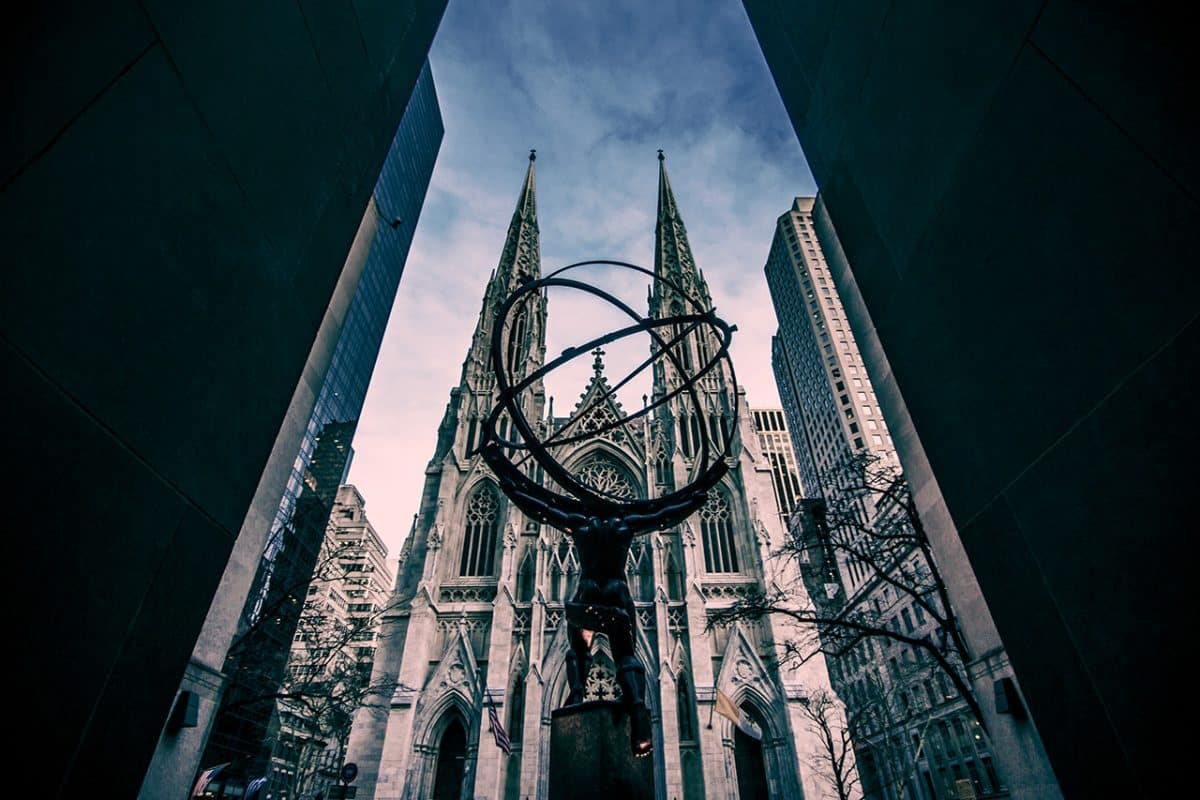
Looking to the future
St Patrick’s Cathedral continues to adapt to contemporary urban challenges. Located in one of the most expensive real estate sectors in the world, it represents an open, free and accessible space in the heart of Manhattan.
Its role as a permanent symbol of the New York landscape seems assured. At a time when the city is constantly changing, with new skyscrapers constantly reshaping its skyline, the cathedral remains an immutable historical and spiritual anchor.
Personalised experiences
For architecture enthusiasts, take the time to observe the details of the column capitals, the sculpted motifs and the structure of the vaults. A specialist guide or a book on neo-Gothic architecture will enable you to fully appreciate the technical subtleties of the building.
Music lovers can find out about the calendar of organ concerts and choral performances, which are often held in the evening and offer an incomparable sound experience in this exceptional setting.
St Patrick’s Cathedral is not just a monument to be visited, it’s a multi-sensory experience to be enjoyed to the full, an interlude of beauty and serenity in the heart of the city that never sleeps.
Admission: free
